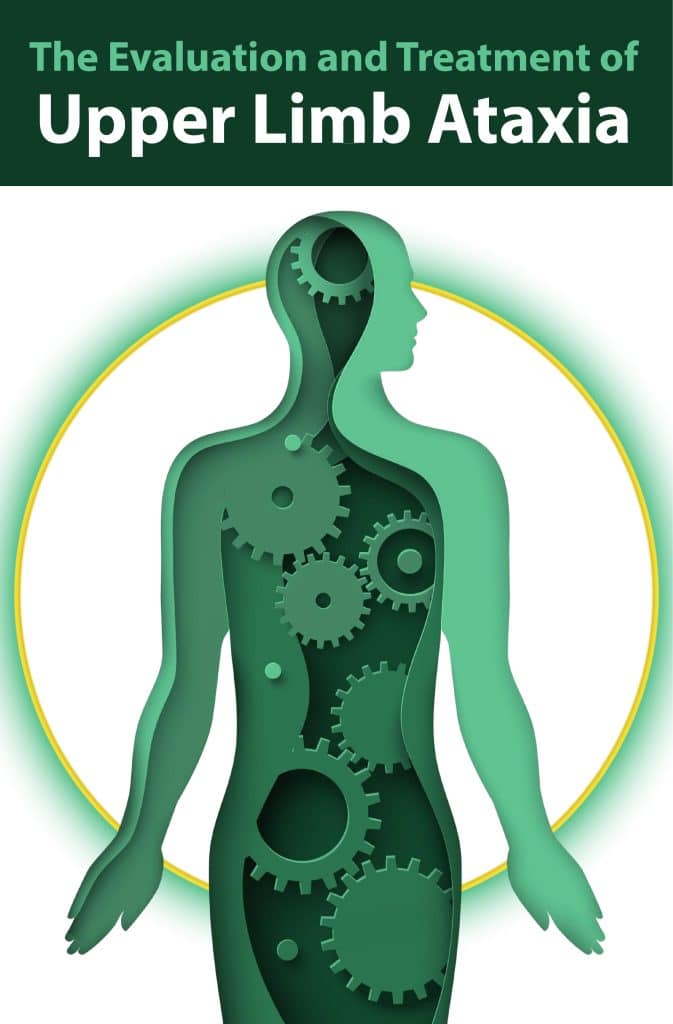The Evaluation and Treatment of Upper Limb Ataxia
Elizabeth Foss, OTR/L, FAS
$39.00
 Learning Level : Intermediate
Learning Level : Intermediate
 Video
Video
Course Preview
Course Abstract
The Evaluation and Treatment of Upper Limb Ataxia is a 3-hour video continuing education (CE) course that provides a detailed overview of ataxia and an exploration of available interventions for the treatment of upper limb ataxia.
Part one of the course reviews the three main types (sensory, vestibular, and cerebellar) of ataxia and discusses the symptoms of each. This is followed by a discussion on the three main causes of ataxia. This course focuses on Cerebellar Ataxia and the physiological symptoms that are associated with it. The instructor takes time to explain the role of the cerebellum in motor synchronization and presents many case studies to exemplify the effects of ataxia on a person’s ability to participate in activities of daily living (ADLs). This is accompanied by a detailed explanation of the mechanics of performing tasks involving balance, equilibrium, and motor planning. The instructor reviews available assessments and screening procedures and provides instructions for performing positional screenings, including finger tests and pen and paper tasks.
In parts two and three the instructor offers detailed information on the two approaches to treatment of upper limb ataxia – restoration (remediation) and compensation (off-setting difficulties). Part two focuses on proximal interventions while part three focuses on distal interventions. Case studies are used to demonstrate patient progress using the strategies discussed. The evidence-based research behind each intervention underscores all information provided. The instructor stresses the importance and value of core, trunk, and postural exercises and highlights the use of oculomotor training. The use of virtual reality and exergames for coordinative training is also examined. The instructor ends the course by sharing information on the types of products available to support clients with daily activities of living, such as dressing, grooming, and eating.
Outline
- Section 1: Evaluation of Upper Limb Ataxia
- Section 2: Treatment of Upper Limb Ataxia, Proximal
- Section 3: Treatment of Upper Limb Ataxia, Distal
Course #31-56 | 2025 | 3-hour video + handouts | 20 posttest questions | Mobile-Friendly
Learning Objectives
- Distinguish between the three main types and causes of Ataxia
- Outline the underlying pathophysiology of eight common clinical characteristics of upper limb Ataxia
- Illustrate the three-minute protocol for screening and evaluating upper limb coordination/tremors
- Compare three common standardized tests for the monitoring and quantification of upper limb ataxia
- Plan how to include evidence-based core, postural and Frenkel exercises to improve upper limb ataxia in practice
- Compare/contrast five types of adapted equipment and assistive devices to achieve personal meaningful ADL goals with individuals with ataxia
Course Directions
This video course provides instant access to the course video, course handout, and the CE test. The CE test is open book (you can print the test to mark your answers on it while watching the course video).
Successful completion of this course involves passing an online test (80% required, 3 chances to take) and we ask that you also complete a brief course evaluation.
About the Author(s)
Elizabeth Foss, OTR/L, FAS : Find out More
Elizabeth Foss, OTR/L, FAS, has been a practicing occupational therapist for 15 years. She specializes in working with neuromuscular populations within the inpatient acute rehabilitation setting. Since graduating from Midwestern University, Elizabeth has worked in various subacute rehabilitation facilities across the Chicago-land area including specialties in orthopedic, psychiatric, and neurorehabilitation. She has also worked within home health settings. Elizabeth presented at the National Ataxia Foundation and John Hopkins Ataxia Center. She also provides educational courses on balance training for Cerebellar Ataxia, neuromuscular re-education for balance retrieval, upper limb ataxia, cooling for Multiple Sclerosis, and upper extremity motor recovery after stroke. Elizabeth served as clinical instructor for 13 years and received The University of Chicago Bea Wade Award for Clinical Education and The Governors State University Clinical Instructor Excellence Award. Elizabeth is certified in LSVT BIG, Otaga, stroke rehabilitation, and Tai-Chi. She is a Certified Functional Aging Specialist and an Older Adult Exercise Consultant. In her spare time, Elizabeth enjoys creating content for her YouTube Channel, Little Steps, Big Gains, watching European soccer, and spending time with her four dogs.
For more information, please visit her website: Little Steps, Big Gains
Disclosure
Financial: Ms. Foss receives author compensation from Professional Development Resources, Inc.
Nonfinancial: No relevant nonfinancial relationships exist.
CE Information
Occupational Therapy

Professional Development Resources is an AOTA Approved Provider of professional development. Course approval ID #13587. This distance learning-independent course is offered at 0.3 CEUs [Intermediate Level, OT Service Delivery/Foundational Knowledge]. The assignment of AOTA CEUs does not imply endorsement of specific course content, products, or clinical procedures by AOTA.
Professional Development Resources is CE Broker compliant (#50-1635 - all courses are reported within two business days of completion).
Customer Testimonials
I really like the presentation style and cadence of the speaker. Very useful!
More Testimonials
- ADHD
- Adults
- Alternative Medicine
- Alzheimers & Aging
- Animal-Assisted Therapy
- Autism
- Behavior Therapy
- Child & Adolescent
- Closeout
- Communication
- Couples-Family-Parenting
- Cultural Diversity
- Depression & Anxiety
- Domestic Violence
- Ethics & Risk Management
- Gender Identity
- HIV-AIDS
- Human Trafficking
- Laws & Rules
- Medical Errors
- Mindfulness & Yoga
- National Psychologist
- Nutrition & Fitness
- Psychotherapy
- Sexuality
- Substance Abuse
- Suicide
- Supervision
- Trauma & PTSD





